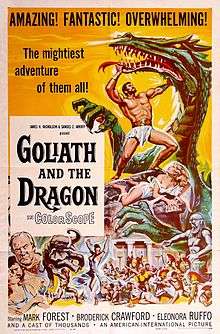Goliath and the Dragon
| Goliath and the Dragon (aka The Revenge of Hercules) | |
|---|---|
 | |
| Directed by | Vittorio Cottafavi |
| Produced by |
Achille Piazzi Gianni Fuchs |
| Written by |
Marcello Baldi Mario Ferrari Marco Piccolo Duccio Tessari Archibald Zounds Jr. (Nicolò Ferrari) |
| Starring |
Mark Forest Broderick Crawford Gaby André Philippe Hersent Leonora Ruffo |
| Music by |
Alexandre Derevitsky Les Baxter (US) |
| Cinematography | Mario Montuori |
| Edited by | Maurizio Lucidi |
| Distributed by | American International Pictures (US) |
Release dates |
Italy: August 12, 1960 |
Running time | 95 min |
| Country | Italy France |
La vendetta di Ercole (literally Revenge of Hercules), better known as Goliath and the Dragon, is a 1960 Italian/French international co-production widescreen peplum film starring weight lifter and gymnast Mark Forest in his debut film role and Broderick Crawford as the villain. The identity of the title character was changed from Hercules to Emilius known as Goliath for release in North America by American International Pictures to tie in with their previous use of "Goliath" in Goliath and the Barbarians (1959). The film features special make up by Carlo Rambaldi.
This version, the most widely seen today, was produced by James H. Nicholson and Samuel Z. Arkoff, with Lee Kresel serving as dubbing director.[1] This version was significantly re-edited and contains a stop-motion dragon sequence by Jim Danforth and Wah Chang, which was not part of the original release.[2] Like other American International Pictures releases of Italian made sword and sandal films, it features a new score by AIP's house composer Les Baxter. This version was remastered and distributed by Something Weird Video.
Plot
The film begins with Hercules/Goliath/Emilius entering the underworld and defeating several monsters including Cerberus to retrieve the Blood Diamond of the Goddess of Vengeance. It is later revealed that King Eurystheus has sent Hercules/Goliath on this task to ensure his death to gain allies who after Hercules' death will join the King in an attack on Thebes. The episode is loosely based on the twelfth of the Labours of Hercules.
Hercules returns to his wife Deianira to find that his teenaged son (his brother in the American version) Hyllus is in love with Thea the daughter of a King that Hercules believes murdered his family. The enraged Hercules refuses to let Hyllus have anything to do with Thea. The scheming Eurystheus has convinced Hyllus that Thea is really in love with Hercules rather than him and concocts a plan where a jealous Hyllus will murder his own brother. A slave girl Alcinoe gives Hyllus a poison to give to Hercules that she says is merely a potion to have Hercules fall out of love with Thea. Eurystheus himself wishes to marry Thea and install her as his Queen.
The plan is aborted through a sympathetic Goddess of the Wind who relays Thea's warning. Hyllus attempts to rescue Thea but is captured. When Hercules rides to rescute Hyllus he saves the life of Alcinoe who is menaced by a bear. Ilus is to be executed with others in a public display by being crushed by an elephant in a crowded arena. Hercules rescues him.
On their return home the two are given a prophecy that Hyllus will become a King but at the cost of the life of the woman who loves Hercules. Hercules destroys his home and leaves with his family to try and avert the prophecy. Dejanira offers her life to the Gods in order to fulfil the prophecy for Hyllus. She is carried off by a Centaur corresponding with Nessus who Hercules mortally wounds.
The Centaur is able to bring his captive Deianira to his friend Eurystheus who intends firstly to let her be killed by his dragon, then to act as a hostage against the vengeance of Hercules.
Cast
- Mark Forest – Hercules/Goliath
- Broderick Crawford – King Eurystheus
- Sandro Moretti – Hyllus
- Gaby André – Ismene
- Philippe Hersent – Androclo
- Leonora Ruffo – Deianira
- Giancarlo Sbragia – Tindaro
- Wandisa Guida – Alcinoe
- Federica Ranchi – Thea
- Carla Calò – Sibyl
- Ugo Sasso – Timocleo
- Claudio Undari – Centaur
- Salvatore Furnari – Midget
US release
AIP announced plans to make a follow up to Goliath and the Barbarians called Goliath and the Dragon from a script by Lou Rusoff with Debra Paget but this fell through and they ended up buying an Italian film called The Vengeance of Hercules and renaming it Goliath and the Dragon[3] after adding an animated dragon sequence.[2]
Reception
The film got mixed reviews. It is listed in Golden Raspberry Award founder John Wilson's book The Official Razzie Movie Guide as one of the 100 Most Enjoyably Bad Movies Ever Made.[4]
References
- ↑ Mark McGee, Faster and Furiouser: The Revised and Fattened Fable of American International Pictures, McFarland, 1996 p154
- 1 2 Goliath and the Dragon (1960) Alternate Versions, Internet Movie Database.
- ↑ Gary A. Smith American International Pictures: The Golden Era, Bear Manor Media 2013 p 144
- ↑ Wilson, John (2005). The Official Razzie Movie Guide: Enjoying the Best of Hollywood's Worst. Grand Central Publishing. ISBN 0-446-69334-0.